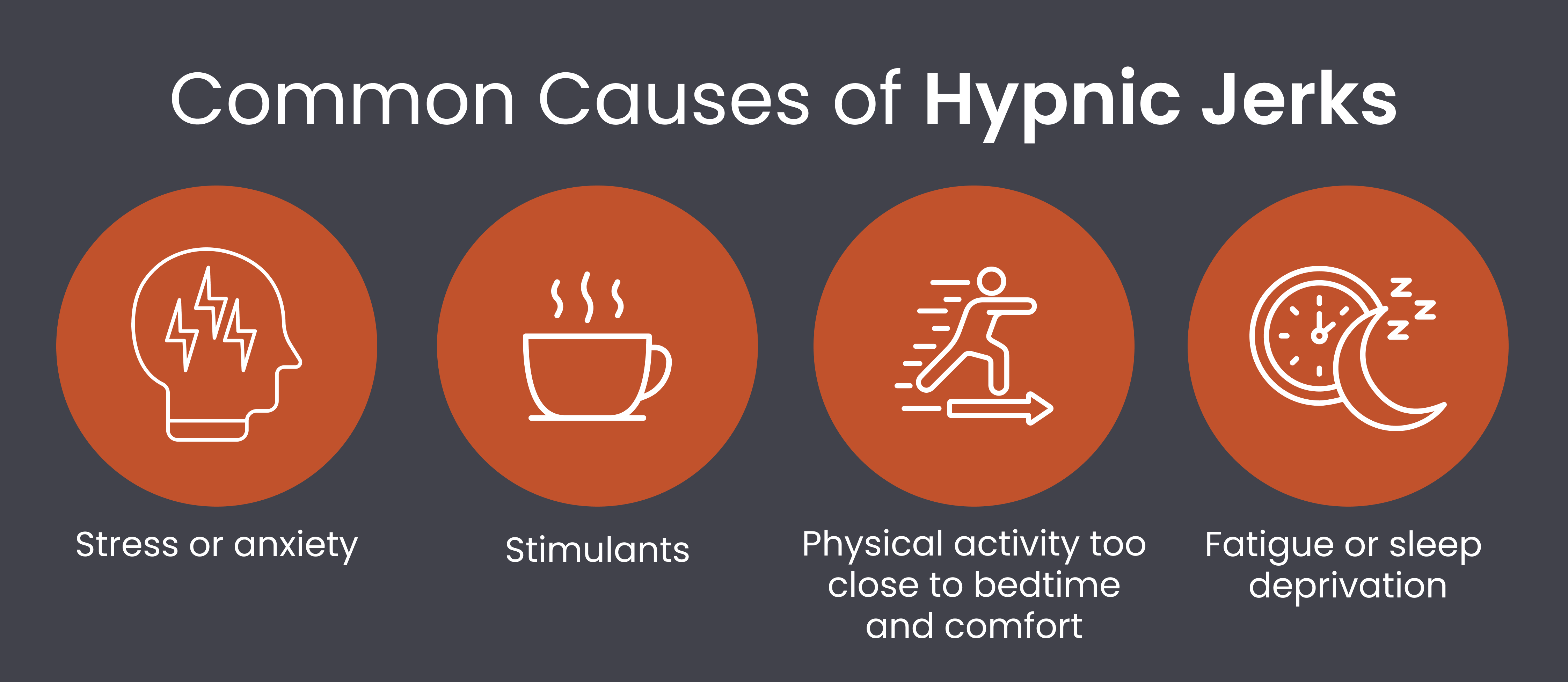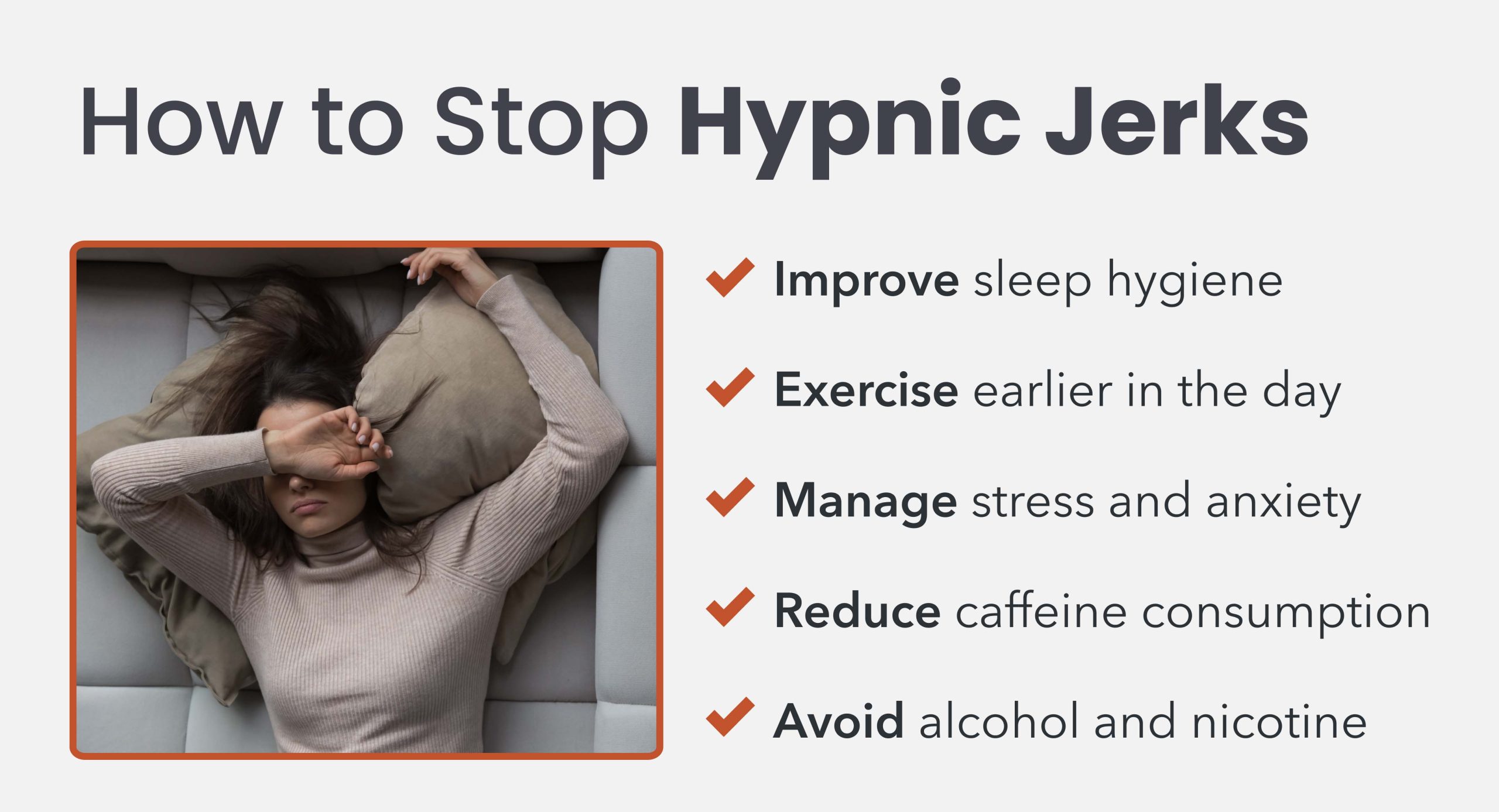Hypnic Jerks: Causes & Prevention Tips

- Key Takeaways
- What Is a Hypnic Jerk?
- What Causes Hypnic Jerks?
- How Do You Stop Hypnic Jerks?
- Are Hypnic Jerks Dangerous?
- Hypnic Jerk FAQs
- Understanding Hypnic Jerks: Why We Twitch at Night
Key Takeaways
- Hypnic jerks are sudden, involuntary muscle spasms that occur as you drift off to sleep.
- Stress, caffeine, evening exercise, and fatigue can trigger hypnic jerks.
- Better sleep habits, earlier workouts, stress management techniques, and avoiding stimulants can reduce the frequency of hypnic jerks.
- Hypnic jerks are usually harmless and affect up to 70% of people, but you should consult a doctor if they become excessive or occur during the day.
- Your sleep setup matters; the right mattress can reduce disruptions and improve overall sleep quality.
What Is a Hypnic Jerk?
A hypnic jerk is a sudden, involuntary muscle spasm that occurs just as you’re falling asleep.[1] You might experience a falling sensation, a flash of light behind your eyelids, or a quick dream fragment alongside the physical jolt. These jerks typically affect the legs or arms but can involve the entire body.[1,2]
The twitches you experience with hypnic jerks occur during the transition between wakefulness and sleep, specifically during the hypnagogic state, which is the period in which you’re not quite asleep but no longer fully awake. Most people experience the sensation of falling or slipping, followed by a sudden, jerking contraction of muscles that snaps them back to alertness.[1]
Unlike the gentle muscle relaxation that normally happens as we drift off, hypnic jerks are abrupt contractions that can be strong enough to wake you completely. While usually brief and isolated, they can be frustrating when they repeatedly interrupt your efforts to fall asleep.
What Causes Hypnic Jerks?
Scientists haven’t pinpointed an exact cause for hypnic jerks, but several factors appear to increase their frequency and intensity. Understanding these triggers is the first step toward reducing their disruption to your sleep:[1]

Stress or anxiety
When your mind is racing with worries, your nervous system remains on high alert. Stress and anxiety can affect the normal transition to sleep, making hypnic jerks more likely. The body’s stress responses release hormones like cortisol, the stress hormone, which can increase muscle tension and nervous system activity right when you need to be relaxing.[3]
Stimulants
Stimulants like caffeine can increase the likelihood of experiencing hypnic jerks. These substances make it difficult for your body to fully relax when bedtime arrives.[3]
The effects of caffeine can last much longer than people realize — up to 10 hours for some people.[4] That afternoon coffee might still be affecting you when you’re trying to fall asleep. Research on caffeine and sleep shows that even small amounts consumed too late in the day can disrupt your sleep.
Physical activity too close to bedtime
While regular exercise generally improves sleep quality, intense exercise before bed can trigger hypnic jerks. Vigorous activity raises your body temperature, heart rate, and adrenaline levels, all of which work against the body’s natural sleep process.[3]
The stimulation from evening workouts can keep you alert when you should be winding down. If you regularly experience hypnic jerks, consider moving your fitness routine to earlier in the day, allowing your body ample time to cool down and relax before sleep.
Fatigue or sleep deprivation
Many people experience more frequent or intense hypnic jerks when they’re overtired or sleep-deprived. While the exact mechanism isn’t fully understood, disruptions to normal sleep patterns can increase the likelihood of these muscle twitches.[3]
When your body is exhausted, the normal processes that regulate the transition between wakefulness and sleep may function less smoothly.
How Do You Stop Hypnic Jerks?
While you may not be able to eliminate hypnic jerks completely, several strategies can significantly reduce their frequency and impact on your sleep quality. By addressing both the environmental and lifestyle factors that contribute to these twitches, you can enjoy a more peaceful transition into sleep. Here’s how to stop hypnic jerks:

Improve sleep hygiene
Creating an optimal sleep environment makes all the difference in reducing sleep disruptions like hypnic jerks. Make your bedroom cool, dark, and quiet to signal to your body that it’s time to sleep. Consider blackout curtains if light pollution is an issue, and use white noise to mask disruptive sounds.
Your sleep surface also influences your sleep quality. An uncomfortable mattress can increase muscle tension and disrupt the transition to sleep. Consider upgrading to a supportive memory foam mattress that reduces pressure points or a hybrid mattress that combines support with gentle contouring. Either option can help your muscles relax as you drift off.
You should also remember to be consistent. Go to bed and wake up at roughly the same time each day. This regularity can synchronize your body’s internal clock, making it easier to fall asleep while preventing hypnic jerks.
Exercise earlier in the day
Physical activity is great for sleep quality when timed correctly. To prevent hypnic jerks, schedule your more intense workouts at least a few hours before bedtime. This timing lets your elevated body temperature, heart rate, and adrenaline levels return to baseline before you hit the pillow.
If you can only exercise in the evening, opt for gentler activities like stretching rather than high-intensity training. These calming forms of movement help release muscle tension without overstimulating your nervous system.
Regular daytime exercise also helps regulate your sleep-wake cycle and reduces overall stress levels, both of which can decrease the frequency of hypnic jerks over time.
Manage stress and anxiety
Since stress is a major trigger for hypnic jerks, incorporating relaxation techniques into your bedtime routine can make a significant difference. Try meditation for sleep or progressive muscle relaxation before bed.
Creating a buffer zone between your busy day and sleep time helps your mind and body transition to a restful state. Avoid work emails, stressful conversations, or stimulating content at least an hour before bed.
For chronic stress or anxiety that regularly disrupts your sleep, talk to your healthcare provider. Sometimes, addressing the underlying anxiety can dramatically reduce sleep disturbances like hypnic jerks.
Reduce caffeine consumption
Drinking less caffeine in the afternoon and evening can help reduce hypnic jerks. Most experts recommend cutting off caffeine at least 6 hours before bedtime, but sensitive individuals might need an even longer window.
Remember that caffeine lurks in more than just coffee. You can also find it in tea, chocolate, some medications, and many sodas. Check labels carefully if you’re trying to reduce your intake.
Some people find that gradually reducing caffeine throughout the day works better than cutting it off abruptly. For example, you might switch to half-caf after lunch and herbal tea in the evening to ease your system into a more relaxed state.
Avoid alcohol and nicotine
Though alcohol might make you feel sleepy initially, it severely disrupts sleep architecture as it metabolizes, often leading to more fragmented sleep and an increased likelihood of hypnic jerks. Research shows that alcohol can affect sleep quality even if you don’t wake up feeling it.
Similarly, nicotine is a stimulant. Smoking before bed might seem relaxing, but it actually works against your body’s natural sleep processes and may result in more frequent hypnic jerks.[3]
If you do consume alcohol, try to finish your last drink at least a few hours before bedtime to give your body time to metabolize it before sleep.
Are Hypnic Jerks Dangerous?
For most people, hypnic jerks are completely harmless. They don’t indicate any underlying health problems and don’t cause any physical damage, despite how startling they can feel at the moment.
However, in some cases, what seems like a hypnic jerk might actually be something else. If you experience muscle jerks during full wakefulness, or if they occur repeatedly throughout the night, it could indicate a different condition. Periodic limb movement disorder, for instance, causes repeated muscle jerks during established sleep rather than just during the transition.
Excessive hypnic jerks that disrupt your ability to fall asleep might also be worth discussing with a healthcare provider, especially if they’re accompanied by other symptoms like usual daytime fatigue, persistent insomnia, or sensations similar to those experienced with restless leg syndrome. Understanding the causes of restless leg syndrome can help distinguish between these different sleep disruptions.
If your sleep jerks are new, dramatically increasing in frequency, or causing significant distress, check in with your doctor to rule out any underlying issues.
Hypnic Jerk FAQs
How common are hypnic jerks?
Hypnic jerks are remarkably common, affecting between 60-70% of the general population, according to sleep research.[5] Most people experience them occasionally, with frequency typically increasing during periods of stress or fatigue. Though nearly universal, many people don’t remember them unless they’re particularly strong or occur repeatedly in one night.
Are hypnic jerks the same as muscle spasms?
No, hypnic jerks differ from typical muscle spasms in several key ways. While muscle spasms can occur anytime and often result from overuse, dehydration, or electrolyte imbalances, hypnic jerks specifically happen during the transition to sleep.
Muscle spasms also tend to last longer and may be painful, whereas hypnic jerks are typically brief, singular contractions that happen in an instant.
Can hypnic jerks wake you up?
Yes, hypnic jerks can definitely wake you up. The sudden muscle contraction, often accompanied by a sensation of falling or a visual flash, can jolt you from the early stages of sleep back to full wakefulness. For light sleepers or those who experience particularly strong jerks, this can delay falling asleep and contribute to insomnia if it happens repeatedly.
Understanding Hypnic Jerks: Why We Twitch at Night
Hypnic jerks are one of sleep’s curious phenomena; they’re common enough to be normal yet strange enough to cause concern. By understanding what triggers these sudden muscle contractions, you can take steps to reduce their frequency and impact on your sleep quality.
Creating optimal sleep conditions, managing stress, timing your exercise appropriately, and being mindful of stimulant consumption can all help minimize these nighttime disruptions. Remember that most hypnic jerks are completely harmless, just a quirky feature of how our brains transition from wakefulness to sleep.
While you might not be able to eliminate hypnic jerks entirely, improving your overall sleep quality can make a significant difference in how they affect you. Investing in a comfortable Layla mattress can help reduce sleep disruptions by providing proper support and comfort that allows your muscles to fully relax. Whether you choose the pressure-relieving benefits of memory foam or the responsiveness of a hybrid design, better sleep quality means your body can move through sleep transitions more smoothly. Browse our mattress collection today.
References
- Lysenko, Liudmila., et al. “Sleep Disruption from Movement Disorders.” Therapy in Sleep Medicine, 2012, pp. 345–360, www.sciencedirect.com/topics/medicine-and-dentistry/hypnic-jerk, https://doi.org/10.1016/b978-1-4377-1703-7.10027-1.
- Johnson, Jon. “What Is a Hypnic Jerk?” Medicalnewstoday.com, Medical News Today, 11 Mar. 2019, www.medicalnewstoday.com/articles/324666#in-children.
- “Hypnic Jerks: Why You Twitch in Your Sleep.” Sleep Foundation, 12 May 2021, www.sleepfoundation.org/parasomnias/hypnic-jerks.
- US), Medicine. “Pharmacology of Caffeine.” Nih.gov, National Academies Press (US), 2025, www.ncbi.nlm.nih.gov/books/NBK223808/.
- Chiaro, Giacomo, et al. “Hypnic Jerks Are an Underestimated Sleep Motor Phenomenon in Patients with Parkinsonism. A Video-Polysomnographic and Neurophysiological Study.” Sleep Medicine, vol. 26, 25 Aug. 2016, pp. 37–44, www.sciencedirect.com/science/article/abs/pii/S1389945716301198, https://doi.org/10.1016/j.sleep.2016.07.011.







